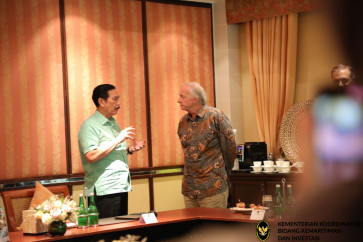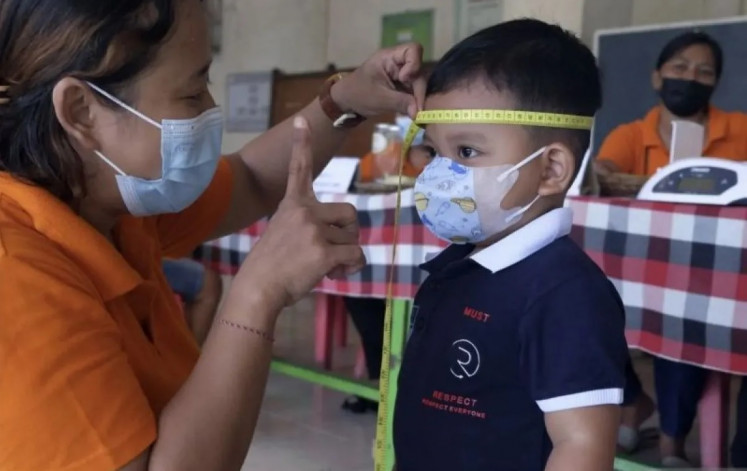Analysis: RTD tea industry: Big opportunity versus higher competition
Indonesia’s ready-to-drink (RTD) tea market has been growing enormously in recent years
Change text size
Gift Premium Articles
to Anyone

Indonesia’s ready-to-drink (RTD) tea market has been growing enormously in recent years. Euromonitor estimates RTD tea sales will grow at a compound annual growth rate (CAGR) of 12.5 percent over the 2015 to 2020 period. That exceeds sales of regular tea bags or powdered tea, projected to expand at a CAGR of 11.3 percent over the same period.
According to the Association of Soft Drink Producers (ASRIM), RTD tea volume has risen above 2 billion liters and contributes about 9 percent to the total Indonesian soft drink market, the second largest after mineral or bottled water (84 percent).
Such robust growth in the domestic RTD tea market can be attributed to three factors.
Firstly, there has long existed in Indonesia a tea-drinking culture. Such a tradition is most notably prevalent among the Javanese people, who usually drink tea at least twice a day — in the morning and afternoon. But nowadays, people can have tea at any time, as the beverage suits any occasion.
Secondly, rapid urbanization has also changed the lifestyle of the people who now seek practicality and comfort as they do not have much time to brew tea.
Thirdly, tea has become an increasingly popular beverage compared to coffee and milk and serves as a top choice among all ages, genders and socio-economic classes.
The significant growth of the RTD tea market has brought in massive investments both from big domestic and international food and beverage companies in recent years.
Sinar Sosro is widely known as the pioneer of RTD tea products in Indonesia and still leads the market with more than 50 percent share through its Teh Botol Sosro brand.
Beverage Partners Worldwide, a joint venture between The Coca-Cola Company and Nestlé, comes in second with Frestea, followed by Mayora with Teh Pucuk Harum, ABC President Indonesia with Nu Green Tea and Ultrajaya with Teh Kotak.
Several global players have also entered the market via joint ventures with major local players. These include Asahi Indofood Beverage Makmur (Indofood and Japan’s Asahi) with Ichi Ocha brand, Suntory Garuda Beverage (Garuda Food-Japan’s Suntory) with Mytea and ITO EN Ultrajaya Wholesale (Ultrajaya-Japan’s ITO EN) with Kiyora.
Each producer tries to launch products in various flavors and packaging to attract consumers and offer them varied options. Some players have also initiated a “second tier” brand to retain their market share, such as Sinar Sosro with S-tee and Fruit Tea.
As more players bolster the market, the RTD tea industry has become more competitive.
Sinar Sosro has seen its market share dwindle from 70 percent in 2013 to 55.6 percent at present.
The Top Brand Award 2017 ranked Teh Botol Sosro first under its RTD tea category with a top brand index (TBI) of 32 percent (versus 33.8 percent in 2016), followed by Teh Pucuk Harum at 22.7 percent (versus 24.8 percent in 2016), Teh Gelas at 12.6 percent (versus 13.1 percent in 2016), Ultra Teh Kotak at 6.8 percent (versus 8.1 percent in 2016) and Frestea at 6.3 percent (versus 7.2 percent in 2016).
Nu Green Tea topped the list of the green tea category with a TBI of 45.8 percent, followed by Frestea Green (16.3 percent), Ichi Ocha (2.8 percent) and Joy Tea (1.9 percent).
The TBI is formulated based on three variables, namely mind share, market share and commitment share.
A mind share indicates a brand’s strength within the minds of consumers of the respective product category, while a market share shows a brand’s strength in a certain market as represented by consumers’ actual buying behavior. A commitment share reveals a brand’s strength in encouraging consumers to buy a product in the future.
In the midst of tighter competition between rivals, advertising and promotional activities play an important role in raising consumer awareness.
The key factors considered to help maintain the market share of consumer goods are proper marketing, distribution and availability of products in the market.
Based on data from AC Nielsen, total advertising expenditure for tea products climbed at a double digit rate within the last decade. Such a marked growth is attributed to RTD tea.
By comparison, the advertising expenditure for RTD tea has surged 11 times in the last decade, while non-RTD tea has risen by only five times.
The top three brands with the largest advertising expenditure last year were Teh Pucuk Harum, which spent Rp 381.7 billion (US$28.51 million), followed by Teh Gelas (Rp 359.6 billion) and Frestea (Rp 298.7 billion), according to Nielsen.
With stronger competition nowadays, players should have a strategy to compete in the RTD tea industry and this can be achieved by focusing on targeted customers, which can provide the right direction for marketing plans.
Amid the current slowdown in the domestic retail market, marketing attempts through a business-to-business (B2B) scheme can also be challenging, given the large market size and relatively stable demand.
With a more customized customer target, the marketing approach is expected to be more targeted. Besides, innovation, preceeded with a thorough market survey, is a must.
In sum, the RTD tea industry is still with prospects given its sheer market size and robust demand growth despite tighter competition.
The implication for the banking industry is that the rapidly expanding RTD industry could serve as a potential sector for bank financing.
Data from the Financial Services Authority (OJK) show that bank loans funneled into the tea processing industry have grown at a CAGR of above 20 percent in the last five years. However, banks should still be prudent to maintain credit quality as non-performing loans of the tea processing industry tended to increase in recent years, according to the OJK. Therefore, this should become a concern for the domestic banking industry.
______________________________
The writer is an industry analyst at PT Bank Mandiri.









